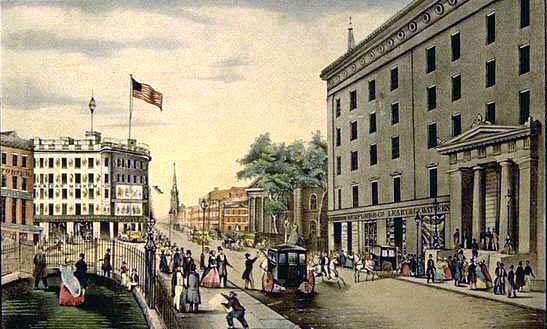
History 2700 MacKay Sectionalism/Reform
The antebellum era--the period from the War of 1812 to the Civil War--was an
era of political democratization, unprecedented reform energies, and explosive
territorial and economic growth. But it also saw the emergence of bitter
sectionalism and political conflicts, and the North and South developed along
diverging lines. The great question haunting the period was whether the spirit
of sectionalism or the spirit of nationalism would triumph. Sectionalism is the
term used to define the sharp socio-economic differences that divided the
Northern and the Southern states in the U.S. pre-1850s.
Economy in the Northern States

Broadway, New York:
South from the Park, a Currier & Ives Print, 1840s
The northern states were slowly being industrialized. Most of the agricultural
work in the north was gradually shifting to the western region. From here, farm
products were shipped to the north and the south on the Mississippi River. In
1820, with the completion of the Eric Canal, and the expansion of the railway
network, the northwest was connected to the north east region. This regional
alliance was to play a significant role in the national politics, in the near
future. During the early 19th century, the northern states witnessed great
changes. Industry and transport had expanded. With the growth of industry, the
need for finance was felt. The New York stock exchange became the country’s
largest center for trade in shares and securities. New York City also became the
center for insurance companies, banks and credit agencies.
Southern Economy

"A Cotton Plantation" 1846, Creator: Henry
Lewis
The Southern economy was primarily an agricultural
economy there. Cotton had become an important crop and was exported to Britain.
The leading cotton producing states were Georgia, Alabama, Louisiana and
Mississippi. The other crops grown in the South were rice, sugar and tobacco.
Farming was carried out on huge farms or plantations as stories and folklore
tell us. In reality, however, less than 1/5th of the farmers owned the huge
plantations in the South. The sharp difference in the economy of the North and
the South led to the rise of serious conflicts on the issues of tariff and
slavery. While the northern states advocated high tariff so as to protect their
industries, high tariff affected the interest of the farmers of the South.
Eli Whitney's invention of the cotton gin gave slavery a new lease on life. Between 1792, when Whitney invented the cotton gin, and 1794, the price of slaves doubled. By 1825, field hands, who had brought $500 apiece in 1794, were worth $1,500. As the price of slaves grew, so, too, did their numbers. During the first decade of the nineteenth century, the number of slaves in the United States rose by 33 percent; during the following decade, the slave population grew another 29 percent.
Northern Reform
Running through many reforms were common themes and assumptions, one of the most important of which was a passionately-held belief that individuals must be able to act as free moral agents, capable of choosing right from wrong, and not restrained by the "arbitrary power" of someone else (like a slaveholder or immoral husband) or something else (like alcohol, bad diet, or mental illness).
Readings:
Recommended Reading: Don't Know: 194-213
Discussion Topics:
Project #16: Explore the Sectional Crisis archives. Work with at least 3 of the primary documents. How do they help you understand emotions as a dynamic of the sectional crisis?
Project #17: Explore the Temperance Archives. How do the primary documents help you better understand this reform in Antebellum America?